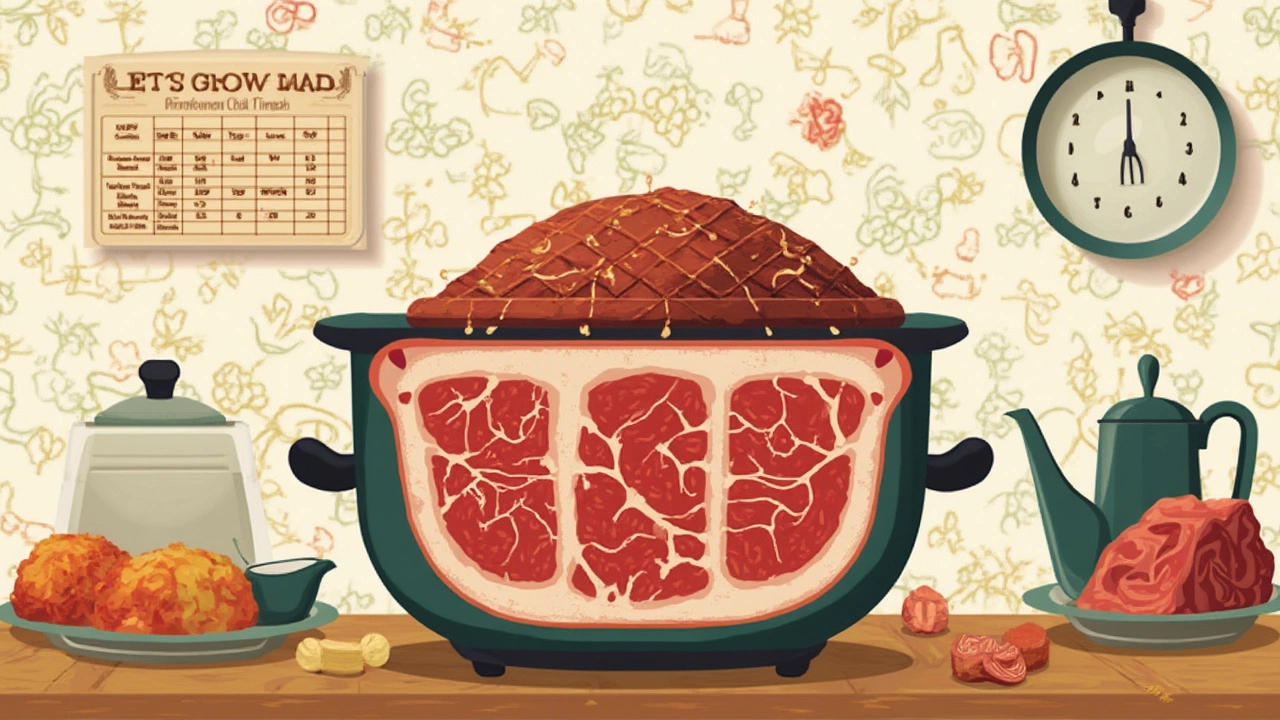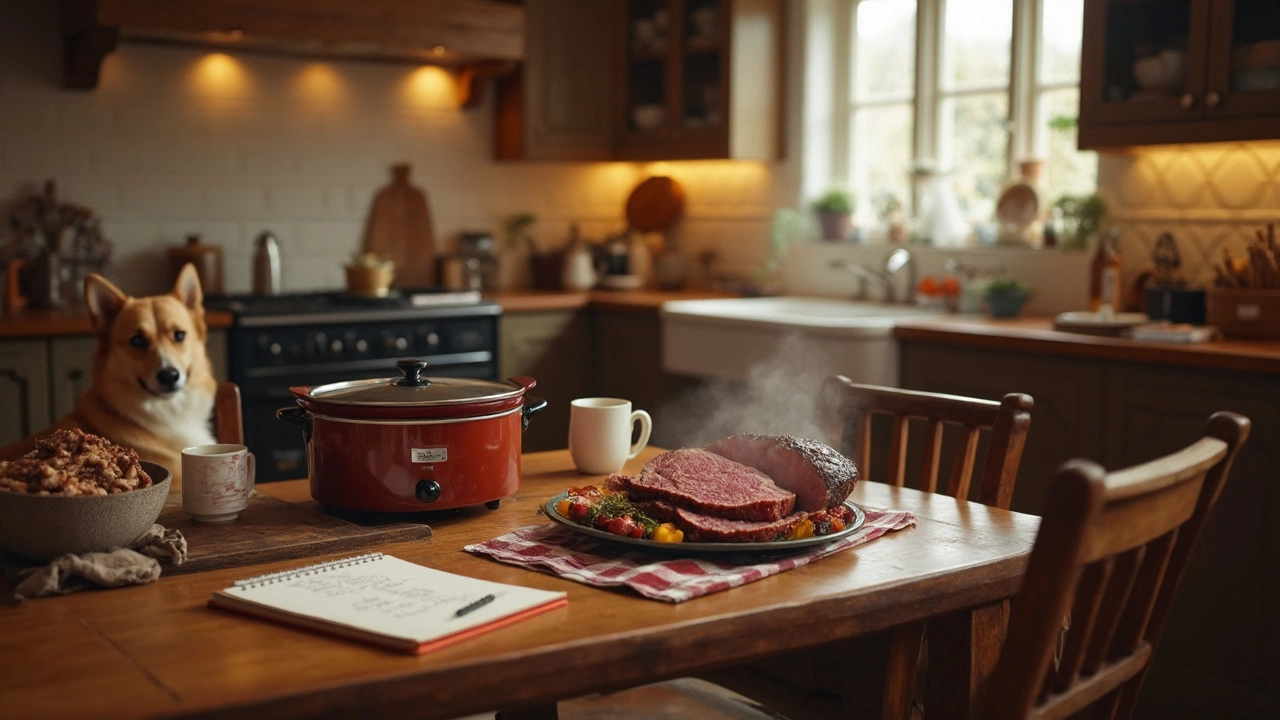Ever thrown a roast in your slow cooker, set it to low, and left it all day—only to come home to a dinner that’s a little... off? It’s a huge letdown when “set it and forget it” turns into “forget it and regret it.” While most people think slow cookers can’t overdo it, the truth isn’t so simple.
Turns out, yes, you really can overcook meat in a slow cooker, even on the low setting. Most slow cooker recipes feel forgiving, but they’re not magic. Meat has a sweet spot: too little time, and it’s tough and chewy; too much, and it falls apart in all the wrong ways, turning stringy or mushy. What’s worse, after those long, dreamy hours, the meat can even taste bland instead of richly flavored.
So how do you hit that perfect point? It’s not just about timing—it’s about the type of meat, its size, your slow cooker itself, and a few little tricks the pros swear by. Knowing what to look out for saves you from the sad surprise of an overdone meal.
- How Slow Cookers Actually Work
- What Happens When You Overcook Meat
- Recognizing the Signs of Overcooked Meat
- How Long Is Too Long for Different Cuts
- Pro Tips for Perfect Slow-Cooked Meat
How Slow Cookers Actually Work
Slow cookers are basically countertop ovens with one job: keep food cooking gently for hours without fuss. They use a ceramic or metal pot, surrounded by a heating element, and run at fairly low temperatures—the low setting usually sits between 170°F and 200°F (77°C to 93°C). This temperature range means you don’t need to babysit your meal or worry about it burning on the bottom (unless you forget you even started it).
Heat rises up the sides of the pot, not just from the bottom, so the whole space warms up evenly. Lids trap moisture, making the inside steamy and preventing your food from drying out. This steady, moist heat is key for breaking down the tough stuff in meats, like collagen and connective tissue. That’s why slow cookers turn cheap, chewy cuts into something you barely need a knife for.
Check out this quick comparison of slow cooker temperature ranges:
| Setting | Temp (°F) | Temp (°C) | Typical Cooking Time |
|---|---|---|---|
| Low | 170–200 | 77–93 | 6–10 hours |
| High | 280–300 | 138–149 | 3–5 hours |
| Warm | 145–165 | 63–74 | Varies |
Slow cookers do their best work when you keep the lid on and resist peeking—it can take 15 to 20 minutes to recover lost heat every time you open it. If you’re aiming to not overcook meat, those little temperature differences and sneaky lid lifts can add up over long hours.
One cool thing: modern slow cookers often switch to “warm” once the timer’s up, which helps protect against disasters. But keep in mind, ‘warm’ is not a fix-all—if you leave meat in there too long, the texture can still go south.
What Happens When You Overcook Meat
Overcooking meat in a slow cooker on low isn’t just about dinner being a little dry. What’s really going on behind the scenes is all about the breakdown of proteins and collagen. Meat starts out tough because of connective tissue. At low, steady heat, slow cookers melt that collagen into gelatin, which is what gives slow-cooked meals their juicy, meaty feel. But give it too much time, and everything falls apart the wrong way.
Here’s what you’ll notice when you push meat past its prime:
- The texture changes big-time. At first, meat gets more tender as collagen breaks down. But after a certain point, the muscle fibers shrink up tightly, pushing out moisture. That means you’ll end up with meat that seems wet but actually feels dry and stringy.
- Flavor takes a hit. The longer meat cooks, the more flavors leach out into the cooking liquid. Instead of getting richer, both the meat and the broth start to taste bland.
- The cut matters. Lean cuts like chicken breast or pork loin dry out and shred into mush much faster than fattier, tougher cuts like brisket or pork shoulder.
According to the USDA, most slow cookers reach temperatures between 170°F and 280°F on low and high settings. Meat proteins start to denature around 140°F and will continue to toughen if held there too long.
| Type of Meat | Ideal Slow Cooker Time (Low) | Signs of Overcooking |
|---|---|---|
| Chicken breast | 3-4 hours | Dry, stringy, chalky texture |
| Chuck roast | 7-9 hours | Mushy, falls apart, greasy liquid |
| Pork loin | 5-6 hours | Dry, crumbly, bland |
So yes, you can totally overcook meat in a slow cooker, even if you’re using low heat. The key is hitting the right balance—enough time to break down collagen but not so much that all the goodness disappears. Keeping an eye on recommended cook times (and knowing your slow cooker’s quirks) keeps dinner safely in that tender zone.

Recognizing the Signs of Overcooked Meat
No one wants to spend hours slow cooking just to end up with meat that’s a disappointment. Spotting when you’ve gone too far is pretty easy once you know what to look for. Overcooked meat in a slow cooker can totally change texture, flavor, and even appearance.
The biggest red flag: your meat is stringy or falls apart in dry shreds instead of juicy chunks. For chicken, it’s almost a paste. For beef or pork, you’ll see fibers separating into tough strands. You might have to douse it in sauce to choke it down, but even that won’t hide the problem.
Another big clue is dryness, even when the meat’s been sitting in liquid for hours. It sounds weird, but the muscle fibers squeeze out all their moisture if they cook too long. What’s left behind? Dry, mealy bites that need to be chewed way longer than they should.
- Texture: Turns stringy, chalky, or even mushy
- Color: Looks dull and gray, not rich and juicy
- Flavor: Surprisingly bland—even if you seasoned well
| Cut of Meat | Perfect Texture | Overcooked Texture |
|---|---|---|
| Pork Shoulder | Fork-tender, juicy chunks | Dry, stringy, breaks into shreds |
| Chicken Breast | Moist, easy to slice | Cottony, falls apart |
| Beef Roast | Soft, sliceable with fork | Mealy, crumbles apart |
Also, watch out for meat that’s swimming in a ton of watery liquid. That’s actually melted collagen and juices that couldn’t hang onto the meat because it was cooked past its limit. The flavor escapes, too, leaving bland bites behind.
"Slow cookers are forgiving, but there’s a point where even a tender cut turns to mush. Once the internal temperature holds way above 190°F for hours, the texture and moisture take a turn." — Kenji López-Alt, Author of The Food Lab
Even with a slow cooker set on low, you can come back to chewy or oddly mushy meat if you let it go too long. Keep an eye on these signs and you’ll get the best results for your next lazy dinner day.
How Long Is Too Long for Different Cuts
If you’re thinking you can just toss any cut of meat in your slow cooker and leave it for twelve hours, it’s time for a reality check. Certain cuts can handle a marathon cook, but others will fall apart or get unpleasantly dry if you push your luck.
Let’s get real about some of the most common meats:
- Beef chuck roast: This one is made for slow cooking. Six to ten hours on low is usually plenty. After that, you risk it getting stringy instead of tender. Don’t go over ten hours, even on low.
- Brisket: Another tough favorite, brisket needs eight to ten hours on low. More than that, you’ll notice it start to crumble and lose flavor punch.
- Pork shoulder (or butt): You can get away with eight to twelve hours on low, but don’t forget it—at the twelve-hour mark, it starts heading for mushy, not juicy.
- Chicken breast: Here’s where people trip up. Chicken breast turns dry fast if you overdo it. Four to six hours on low is often enough. Any longer, and even the sauce can’t save it.
- Chicken thighs: These are more forgiving, at six to eight hours on low, but past eight hours, the meat texture starts to get weird and falls off in shreds that aren’t fun to eat.
The overcook meat problem really comes down to protein and fat. Tougher cuts loaded with connective tissue (like chuck, brisket, or pork shoulder) break down slowly and need that low-and-slow magic. Leaner cuts like chicken breast or pork loin just get chalky and dry if you forget the clock. Fish is even more delicate—think one to two hours, max, or it’ll turn to mush.
If in doubt, check for doneness at the minimum recommended time. And keep in mind, newer slow cookers often run a little hotter than the old models—another reason timing matters more than you think.

Pro Tips for Perfect Slow-Cooked Meat
Getting that juicy, fall-apart meat isn’t just dumb luck; it’s about following a few solid rules every time you hit the slow cooker. Let’s lay it out, step by step, so you skip the sad “I left it too long again” moment.
- overcook meat isn’t just about time—it’s about keeping track of the right cut. Tougher cuts like chuck roast or pork shoulder love slow, low heat. Lean cuts (think chicken breast or pork loin) get dried out if you’re not careful. Always pick the right meat for your recipe.
- Fill your slow cooker only halfway to three-quarters full. Overfilling means uneven cooking; underfilling risks burnt edges.
- While it’s tempting to peek, resist the urge to lift the lid unless the instructions tell you to. Every time you open the lid, you drop the temperature by about 10–15°F and slow things down. Your patience pays off here.
- Use a meat thermometer if you want to be sure about doneness. For example, beef roasts do best at 190–205°F for shredding, but chicken is safe at 165°F.
- Pay attention to cook times by cut. Here are the sweet spots for common slow-cooker meats on the "low" setting:
| Meat Cut | Cook Time (Low) |
|---|---|
| Chuck Roast | 8–10 hours |
| Pork Shoulder | 8–10 hours |
| Pork Loin | 5–6 hours |
| Chicken Breast | 3–4 hours |
| Chicken Thighs | 6–7 hours |
Want the tastiest result? Layer aromatics like onions or garlic at the bottom, place meat on top, and add just enough liquid (broth, water, or sauce) to cover about one-third of the meat. And if your slow cooker runs hot—or you're leaving for work—use a plug-in timer to keep things from going too long.
Last thing: When the timer ends, don’t let meat sit in the cooker on "keep warm" mode for hours. This keeps cooking it, just slower. If you can’t eat right away, move the meat to a container and refrigerate it. This move saves your dinner from bland mushiness. Stick to these basics, and you’ll get perfect, slow-cooked meat every time, no matter what you’re cooking.

